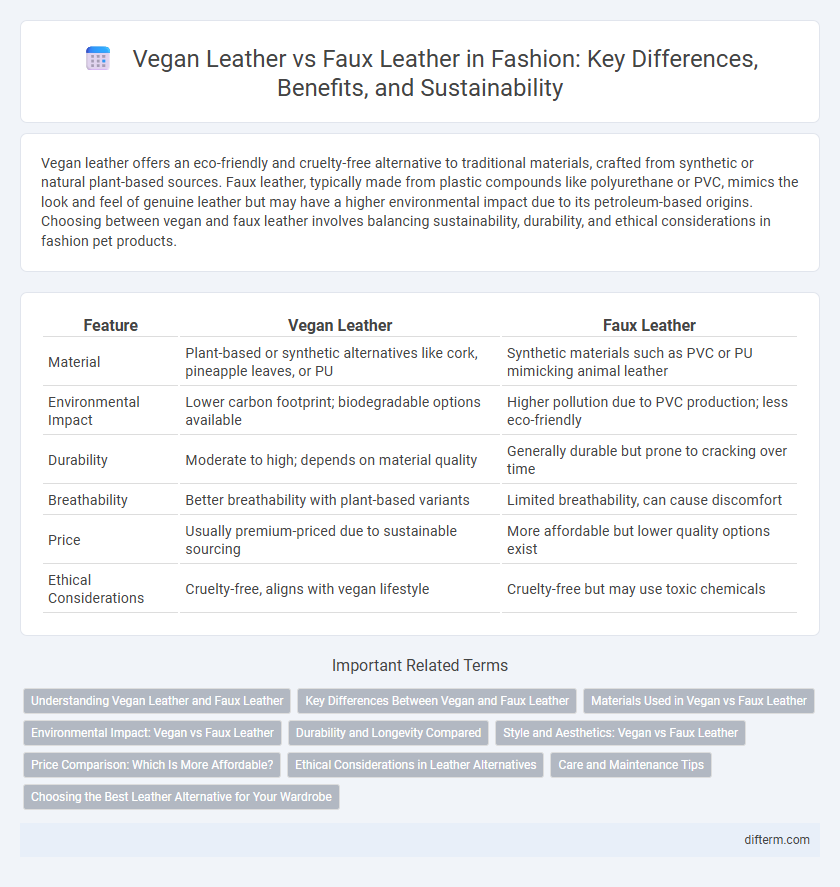Vegan leather offers an eco-friendly and cruelty-free alternative to traditional materials, crafted from synthetic or natural plant-based sources. Faux leather, typically made from plastic compounds like polyurethane or PVC, mimics the look and feel of genuine leather but may have a higher environmental impact due to its petroleum-based origins. Choosing between vegan and faux leather involves balancing sustainability, durability, and ethical considerations in fashion pet products.
Table of Comparison
| Feature | Vegan Leather | Faux Leather |
|---|---|---|
| Material | Plant-based or synthetic alternatives like cork, pineapple leaves, or PU | Synthetic materials such as PVC or PU mimicking animal leather |
| Environmental Impact | Lower carbon footprint; biodegradable options available | Higher pollution due to PVC production; less eco-friendly |
| Durability | Moderate to high; depends on material quality | Generally durable but prone to cracking over time |
| Breathability | Better breathability with plant-based variants | Limited breathability, can cause discomfort |
| Price | Usually premium-priced due to sustainable sourcing | More affordable but lower quality options exist |
| Ethical Considerations | Cruelty-free, aligns with vegan lifestyle | Cruelty-free but may use toxic chemicals |
Understanding Vegan Leather and Faux Leather
Vegan leather is crafted from synthetic materials such as polyurethane or natural alternatives like cork and apple peels, designed to mimic the texture and appearance of genuine leather without animal products. Faux leather, often used interchangeably with vegan leather, primarily refers to plastic-based composites like polyvinyl chloride (PVC), which imitate leather's look but differ in environmental impact and durability. Understanding the material composition and sustainability aspects of vegan and faux leather helps consumers make informed choices in ethical fashion.
Key Differences Between Vegan and Faux Leather
Vegan leather is typically made from natural materials like cork, pineapple leaves, or mushroom, offering a sustainable and eco-friendly alternative to traditional leather. Faux leather is commonly crafted from synthetic polymers such as polyurethane or polyvinyl chloride, providing a more affordable and water-resistant option. Key differences include material composition, environmental impact, and breathability, with vegan leather generally favored for its biodegradability and cruelty-free attributes.
Materials Used in Vegan vs Faux Leather
Vegan leather is primarily made from natural plant-based materials such as pineapple leaves, cork, apple peels, and cactus, creating an eco-friendly alternative to animal-derived leather. Faux leather, also known as synthetic leather or PU leather, is typically produced from polyurethane or polyvinyl chloride (PVC), relying on petroleum-based plastics. The key difference lies in vegan leather's emphasis on sustainable, biodegradable sources, while faux leather focuses on synthetic materials that mimic the appearance of genuine leather but often lack environmental benefits.
Environmental Impact: Vegan vs Faux Leather
Vegan leather, often made from plant-based materials like pineapple leaves or mushroom mycelium, offers a lower environmental footprint by reducing reliance on petrochemicals and minimizing toxic waste compared to traditional faux leather, which is primarily composed of polyvinyl chloride (PVC) or polyurethane (PU). The production of faux leather involves significant greenhouse gas emissions and non-biodegradable waste, contributing to long-term environmental pollution. Sustainable vegan leather alternatives enhance biodegradability and resource efficiency, aligning with eco-conscious fashion trends aiming to reduce the industry's carbon footprint and plastic pollution.
Durability and Longevity Compared
Vegan leather, made from synthetic or plant-based materials like polyurethane or apple peels, generally offers higher durability and better resistance to cracking and peeling compared to faux leather, which often uses lower-quality plastics. Faux leather tends to degrade faster under exposure to heat and moisture, resulting in a shorter lifespan. Premium vegan leather options provide enhanced longevity, making them suitable for sustainable fashion that balances style with durability.
Style and Aesthetics: Vegan vs Faux Leather
Vegan leather offers a more sophisticated and authentic texture that mimics genuine leather's grain, providing a polished and high-end appearance ideal for luxury fashion pieces. Faux leather often exhibits a shinier and more plastic-like finish, which can sometimes appear less natural and more cost-effective. Style-conscious consumers seeking durability with an ethical edge frequently prefer vegan leather for its ability to blend modern aesthetics with sustainability.
Price Comparison: Which Is More Affordable?
Vegan leather typically commands a higher price point than faux leather due to its use of innovative, sustainable materials such as polyurethane or plant-based alternatives like pineapple or mushroom fibers. Faux leather, often made from cheaper plastic-based materials like PVC, remains more affordable and widely available in the market. Consumers prioritizing budget-friendly options tend to choose faux leather, while those seeking eco-conscious products are willing to invest more in vegan leather despite the price difference.
Ethical Considerations in Leather Alternatives
Vegan leather, made from plant-based or synthetic materials, offers an ethical advantage by reducing animal cruelty compared to traditional leather. Faux leather, often derived from plastics like polyurethane or PVC, raises environmental concerns due to its non-biodegradable nature and toxic manufacturing processes. Choosing leather alternatives involves balancing animal welfare with sustainability, prompting innovation in biodegradable and cruelty-free materials within the fashion industry.
Care and Maintenance Tips
Vegan leather requires regular wiping with a damp cloth and mild soap to prevent dirt buildup, while avoiding harsh chemicals that can damage its surface. Faux leather benefits from similar gentle cleaning but should also be conditioned periodically with synthetic leather conditioner to maintain flexibility and prevent cracking. Both materials thrive with proper storage away from direct sunlight and extreme temperatures to extend their lifespan.
Choosing the Best Leather Alternative for Your Wardrobe
Vegan leather, made from sustainable plant-based or synthetic materials, offers durability and eco-friendly benefits, making it ideal for environmentally conscious fashion enthusiasts. Faux leather, often crafted from polyvinyl chloride (PVC) or polyurethane (PU), provides a versatile and affordable option with a wide range of textures and finishes. Selecting the best leather alternative depends on prioritizing factors like environmental impact, budget, durability, and desired aesthetic for your wardrobe.
Vegan leather vs faux leather Infographic

 difterm.com
difterm.com